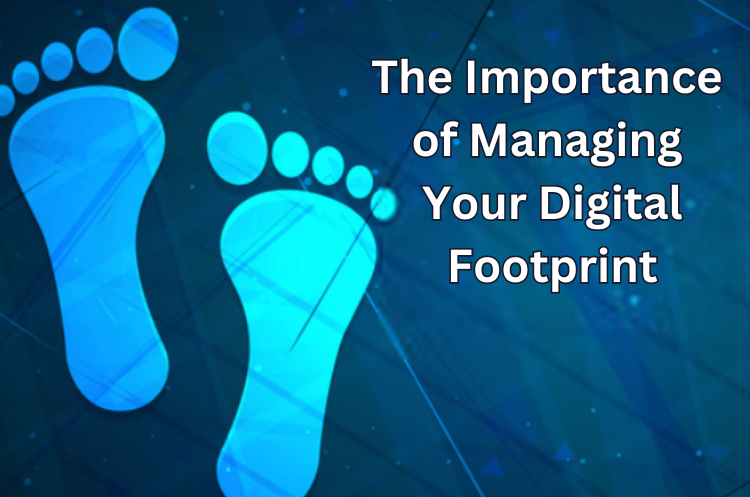
Understanding Digital Footprint
In today’s rapidly evolving digital landscape, our activities online leave a trail of data known as a “digital footprint.” This footprint encompasses the various traces we leave behind as we navigate the internet, engage with websites, interact on social media, and make online transactions. It’s crucial to grasp the concept of digital footprints and their impact on our online presence and privacy.
Defining Digital Footprint
Simply put, a digital footprint is the collection of information that results from our online actions. It’s the record of our virtual interactions and activities, spanning from the content we share on social media to the websites we visit and even our online purchases. This trail is made up of both active and passive footprints.
Active vs. Passive Footprints
Active footprints are generated intentionally by our actions. For instance, when we post on social media platforms, leave comments on websites, or fill out online forms, we’re consciously creating an active digital footprint. On the other hand, passive footprints are produced involuntarily, often without our direct input. These include data like IP addresses, browsing history, and search engine queries. These passive traces accumulate as we browse the internet, forming a detailed picture of our online behavior.
The Importance of Managing Your Digital Footprint

Understanding and managing your digital footprint is crucial for maintaining your online reputation and safeguarding your personal information. Every piece of content you create or engage with contributes to the digital image that others perceive of you. This can have both positive and negative consequences.
For instance, employers, educational institutions, and even potential partners may review your online presence as part of their decision-making process. A well-maintained digital footprint can work in your favor, portraying you as a responsible and respectable individual. However, a careless digital trail might raise red flags or harm your reputation.
Risks and Consequences
Being unaware of your digital footprint’s implications can lead to various risks. Cybercriminals can exploit your digital trail for malicious purposes, such as identity theft or fraud. Sensitive information shared online might be exposed in data breaches, compromising your privacy and security. Moreover, the data you generate can be collected and analyzed by companies for targeted marketing or other purposes.
Steps to Manage Your Digital Footprint
Mindful Sharing: Be cautious about the content you post on social media and other platforms. Once information is online, it can be challenging to remove it entirely.
Privacy Settings: Regularly review and update your privacy settings on social media and other online accounts. This helps you control who can access your information.
Separation of Accounts: Consider using separate accounts for personal and professional use. This minimizes the risk of sharing inappropriate content with unintended audiences.
Strong Passwords: Use strong and unique passwords for different online accounts. This prevents unauthorized access to your accounts.
VPN Usage: Employ a Virtual Private Network (VPN) to encrypt your online connection, adding an extra layer of security to your browsing activities.
Regular Review: Periodically review your online presence and the information you’ve shared. This helps you identify and rectify any potential issues.
The Expanding Digital Footprint Landscape
In the modern interconnected world, our digital footprints continue to grow and evolve. Data companies gather and analyze this information to tailor marketing campaigns and build user profiles. It’s essential for us to take control of our digital footprints and proactively protect our online identities.
Conclusion
Our digital footprints play a pivotal role in shaping our online persona and reputation. Active and passive footprints contribute to the digital trail we leave behind as we navigate the internet. By being mindful of our online actions, understanding the risks, and taking proactive steps to manage our digital footprints, we can ensure our online presence remains positive and secure. In this digitally-driven age, it’s up to us to harness the power of our digital footprints responsibly and safeguard our digital identities.
Adding Build Brand Better – Your Reputation’s Guardian
In the pursuit of an impeccable digital reputation, we, at Build Brand Better, stand as your steadfast ally. In an era where every online action shapes your image, we take pride in offering comprehensive online reputation management services that empower you to assert control over your digital footprint.
Why Choose Build Brand Better?
Tailored Strategies: Just as each individual’s online presence is unique, our strategies are customized to align with your distinct needs. We craft personalized plans that resonate with your goals, ensuring your online reputation remains unblemished.
Expertise and Experience: With years of experience in the realm of online reputation management, our team comprises seasoned professionals who understand the intricacies of digital footprints. We employ cutting-edge techniques to bolster your digital standing.
Proactive Monitoring: At Build Brand Better, we don’t just react; we proactively monitor your digital presence. This allows us to swiftly address any potential issues before they escalate, thereby preserving your reputation.
FAQ
Q1: What is a “digital footprint,” and how is it formed?
A1: A digital footprint refers to the traces of data left behind by our online activities. It encompasses interactions on websites, social media, and online transactions, forming a record of our virtual actions.
Q2: What are the differences between “active” and “passive” footprints?
A2: Active footprints are intentionally created through actions like posting on social media or filling out online forms. Passive footprints are generated involuntarily, including data like IP addresses and browsing history.
Q3: Why is managing your digital footprint important?
A3: Managing your digital footprint is crucial for maintaining your online reputation and protecting your personal information. It can influence decisions made by employers, educational institutions, and potential partners.
Q4: What are the risks associated with an unmanaged digital footprint?
A4: An unmanaged digital footprint can lead to risks such as cybercriminal exploitation, exposure of sensitive information in data breaches, and targeted marketing based on your online behavior.
Q5: What steps can individuals take to manage their digital footprints effectively?
A5: Steps include being cautious about what you share online, regularly updating privacy settings, using strong passwords, considering separate accounts for personal and professional use, and employing a VPN for added security.
For more Blogs:- www.buildbrandbetter.io/blog/
